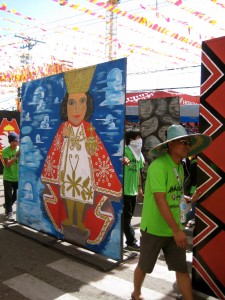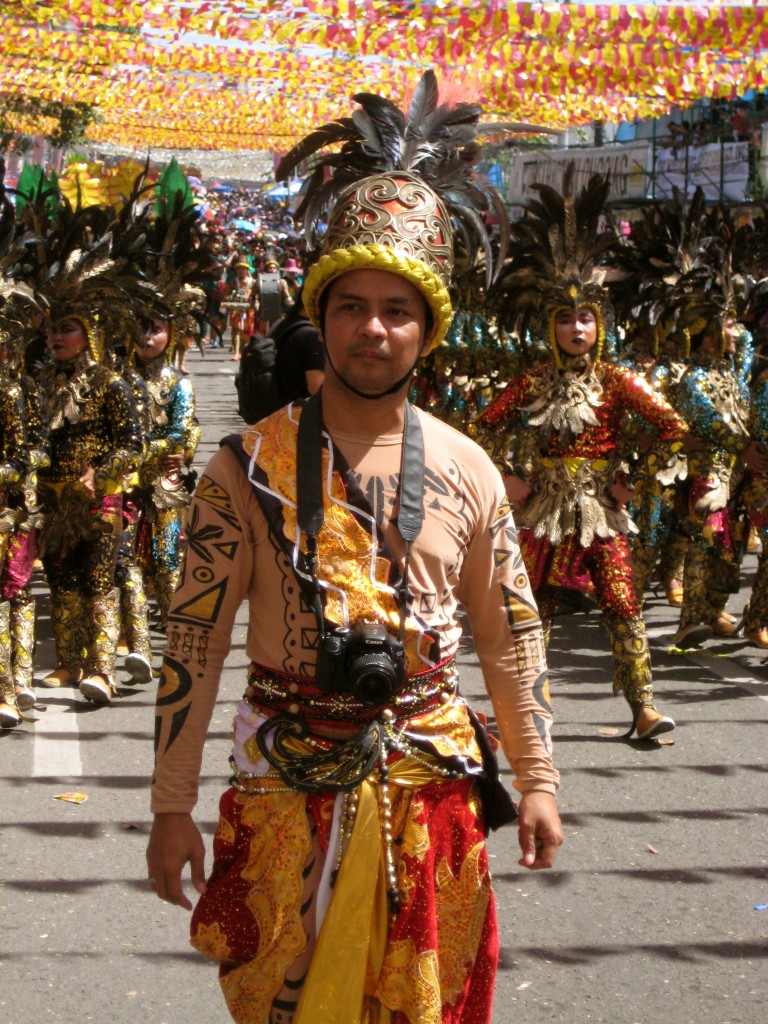Today’s blog was written by an International Justice Mission (IJM) Legal Fellow, Walton Walker. Walton is currently serving in the Cebu, Philippines field office, and as a part of one of our partnerships on the ground, I thought you might like to read some of his observations and admonitions– it’s well worth the read. Currently, at My Refuge House 100% of our residents have on-going legal cases that are represented by IJM lawyers. –Crystal
Prayer Requests: There is an urgent need of shelter: Shelters for boys victimized by sexual exploitation, shelters from overwhelming workloads on a short-handed staff, and shelters for our integrity amidst high pressure to perform.
Endgame
Executive Summary: Strategic contests lead to strategic thinking. Soviets, Screwtape, and self-awareness. Surviving Sinulog. Small things, big God.
They were watching, waiting. A teenage boy in a basketball jersey lay on his stomach over a blue mat. Two men sat in chairs. Light passed through the smudged windows of the shelter, casting a gray haze over a plastic table, a few half-eaten bags of chips and candy, some fans, a television, and the human rights volunteer’s view of his own dreams and motivations.
I reached into a bag and pulled out a chess board, borrowed from one of my IJM coworkers. “I heard you played,” I said to the boy. He laughed and looked away. One of the men spoke a few words in the native language. The boy smiled sheepishly, then answered. I couldn’t understand.
“He doesn’t know chess,” the man said.
“I see,” I said, pondering what I misunderstood when the IJM social worker asked me, perhaps the least linguished of the office’s staff, to converse and play chess with a boy who evidently neither played chess nor spoke English. My t-shirt stuck to my back with sweat from the trip to the shelter under 80-degree heat; a layer of grimy dampness that seemed to thicken with each passing moment that I stood awkwardly holding a heavy glass chessboard, being stared at and staring back, wondering if everyone shared my question about what, exactly, we were doing here.
Some could have answered the question more easily than others, I suppose. The two men had relatively singular and straightforward incentives—they were being paid to stand guard over the boy. The boy’s story, in turn, was a bit more complex. An older foreign man had sexually exploited him. He had been placed in the government processing center for protection during the trial, but what had started as a temporary solution for his housing situation had stretched into weeks and then months due to a lack of suitable shelters for boys in the country.
And what brought me there? Well, I guess that could have been the most hazy matter of all.
Did I visit to minister to the boy, to share an image of Christian love that could replace the warped one he had received? Was I trying to provide an hour or two of companionship to a child who might need a friend?
Or, rather, did I come to encourage testimony from a helpful witness? And if just to encourage testimony, would that be wrong? Or would it be legitimized by the justice reaped from a conviction—justice not only for the boy, but for the larger population of children who had been abused or might be abused by his oppressor?
Or, then again, were all of these reasons merely smokescreens I had manufactured to conceal an underlying drive that was wholly selfish—did I actually go to that shelter for the sake of appearing kind and magnanimous in the eyes of my coworkers? Or, perhaps, to have a good story to tell a friend, or an employer, or an audience of supporters via email?
And, considering circumstances beyond the immediate situation, how much of this current debate could be traced back to my decision to travel in the first place? Christian mission? Adventure quest? Escape maneuver? Was it even possible to so distinctly separate one from the other?
“He knows how to play Dama,” the man explained, graciously drawing me from my own mental labyrinth. “Would you like to learn?” I shrugged and nodded, and the boy arranged the chess pieces across the board, three rows set in an alternating square-by-square arrangement. He moved a pawn diagonally. I mimicked with a knight. And then I watched as the pawn jumped the knight and the boy removed the vanquished piece from play.
I frowned. Pushing my rook forward, I watched the boy respond with a move from his bishop—again one diagonal space. And within two more turns my rook was gone too. But as I watched, I suddenly recognized in his movements the patterns of an age-old game: a game requiring singular attention to each piece and maneuver, but balanced in the perspective of the larger strategy; where light and dark pieces moved across a dark and light plain in the light and dark hands of two players, each holding swirling maelstroms of dark and light within themselves.
In other words, the game was checkers. And litigation. And something bigger. The opponent was the boy. And myself. And something bigger. They were watching, and I was sweating under the weight of humidity and responsibility. My move.
***
In 1984, 22-year-old Garry Kasparov played Anatoly Karpov for the World Chess Championship. The first player to win six games would take the title. Karpov, who had reigned for ten years, quickly jumped to a 4-0 advantage, and some commentators predicted a 6-0 sweep. Then, something happened: over the next 37 games, the players battled to 35 draws, with Kasparov and Karpov winning one game a piece, and the overall momentum swinging to Kasparov’s favor. Kasparov won games 47 and 48 to bring the score to 5-3, at which point the president of the international chess federation abruptly and controversially cancelled the match and announced that the contest would begin anew in six months. Yet in the rematch Kasparov capitalized on his earlier lessons to win by a narrow margin of 13-11.
In his book Life Imitates Chess, Kasparov describes how the early losses of the “Marathon Match” triggered a tactical change: “My team and I spent so much time thinking about how Karpov played, which strategies he would employ, that I uncannily felt as if I were becoming Karpov. During the hundreds of hours of play and preparation I also got a good look at my own play, and at my own mind.” He asserts that this “self-awareness,” the ability to identify one’s own thoughts and motivations, and the humility to analyze them critically, lays the foundation for success in life: “Every decision stems from an internal process, whether at the chessboard, in the White House, in the boardroom, or at the kitchen table.”
Reviewing Kasparov’s particular formulation and application of this thesis is a task probably best left for someone else—perhaps someone who has actually read past the introductory material available on Amazon.com. But it’s worth noting that the chess master was not the first to note the importance of being sensitive to one’s own internal processes and motivations. The challenge to “Know Thyself” appeared on the temple of Delphi, and the saying has been attributed to an epic catalogue of ancient Greek philosophers. John Calvin begins his first Chapter in The Institutes of the Christian Religion with the principle that “Without knowledge of self, there is no knowledge of God.” C.S. Lewis’s fictional demon Screwtape presents the matter with a more diabolical perspective in the various subtle ways he attempts to manipulate “processes…set at work in [humans] centuries ago,” to drain mankind’s faith and imagination—little habits of thought or action that slowly take root in the soul.
Unfortunately, that journey to self-awareness usually isn’t easy. And it usually isn’t clearly marked. Because the world is broken, and people are people, and all of it is ruled by multiple conflicting forces. Confusingly, and sadly, history indicates that embarking on a Christian path doesn’t necessarily make things much clearer.
***
In January, members of my church, office and city crossed one of the spotted plains with the annual celebration of the Sinulog Festival (see attached photos). “Sinulog,” derived from a word meaning “water current movement,” refers to a back-and-forth dance ritual performed by Filipinos. As recorded in the Festival’s official web site, the steps of the Sinulog dance originated as a pagan religious rite among the archipelago’s natives prior to the arrival of the Spanish. According to the story, when Magellan arrived in 1521 he presented a local village chief with a small statue of a caucasian child dressed in a linen blouse and velvet hat, similar to images made in Flanders, Belgium at the time. Magellan referred to the statuette as the Santo Niño, the image of the Infant Jesus, given as a baptismal gift in the course of converting the population to Christianity. The natives then adapted the Sinulog dance earlier used for other gods and used it to honor the image.
Magellan’s expedition ended disastrously, but 44 years later Miguel Lopez de Legaspi followed Magellan’s steps and arrived on a mission to “bring to the natives…a knowledge of the holy Catholic faith.” After annihilating the village and burning its homes, Legaspi’s missionary force found the statue lying in a wooden box among other native idols. The Spaniards constructed a wooden shrine for the image, which was replaced by a stone church in the 17th century. Over time, the Santo Niño received a crown, a military uniform and an embroidered cope. The statue has been associated with numerous healings, while surviving fire and World War II bombings. Reproductions can be found on dashboards and mantlepieces across the islands.
In 1980 a city official organized a Sinulog parade and street dance. The event quickly gathered the attention of party-loving Filipinos, and now represents one of the nation’s biggest tourism events. An estimated 4 million people attended this year’s celebration, which included beauty pageants, marathons, and the singing competition “Sinulog Idol.” In late 2012, when Hurricane Pablo missed the island that harbors the Santo Niño en route to devastating other islands nearby, the island’s governor called for thanksgiving to “the Santo Niño, Our Lady of Guadalupe and San Pedro Calungsod [a newly-canonized local saint].”
With shadows of a more fundamental theological debate, the festival and the veneration of Santo Niño is a source of controversy between many evangelicals and Catholics. Some Protestants renounce the festival as a form of idolatry, a remnant of the pagan past in which worshippers attribute divine power to a fixed image of the Almighty, rather than the infinite and unimaginable Almighty Himself. Catholic observers usually respond that they use the icon as a symbolic means to focus their minds on Christ. Both positions are joined by a third camp—probably the most numerous of all—which treats Sinulog as a mere excuse to party, more bacchanalian than Christian in theology, not unlike Mardis Gras in New Orleans.
Who’s right? Does representing Christ as an infant inspire a childlike faith, or childish ways? Does the festival represent the triumph of Christianity in the Philippines, or its ongoing captivity to paganism? Can the holiday’s observance be a matter of the heart, or is it an absolute wrong?
Now, lest we fall into the trap of considering this an obscure debate only relevant to people halfway across the globe, consider another religious festival with traditions that originated in pagan rites, banned in the past for its questionable Scriptural grounding and riotous manner of celebration, which today seems associated with commercialism as much as the infant Savior that it purportedly honors: Christmas.
The point is mainly to illustrate the subtle distinctions by which sin can blend into sacred, and vice-versa. This is potentially a terrifying realization—at least for me. But it seems helpful to consider that, oftentimes, the steps to salvation or idolatry don’t occur with a single major move, but in small increments: how we deal with the person who cuts us off in traffic on the way to work, how we greet our coworkers every morning, what we tell our loved ones at the end of a long and stressful day. And perhaps that offers added encouragement to remain aware of how the small, seemingly insignificant choices and actions we take in the ordinary moments of ordinary days might carry us to claim our spiritual crowns,[1] or to lose them.
***
A few small, seemingly insignificant practices in IJM’s offices are helping this organization to keep in touch with the larger strategy. For instance, employees begin each day with a single, small, unified movement—to Stillness. For thirty minutes, each employee and volunteer puts aside the emails and agendas to meet with God. Then, the teams meet to share their prayer concerns before lunch. Prayer retreats and prayer gatherings occur throughout the year. Each staff member is allotted one personal day of solitude each year for spiritual reflection. IJM also invites others into the work. For instance, you can participate by becoming a prayer partner, or by attending the upcoming Global Prayer Gathering from April 5-7 in Washington, D.C. “Seeking justice begins with seeking the God of justice,” writes Bethany Hoang, the director of the IJM Institute for Biblical Justice in a resource distributed to staff members. Working for an organization that acknowledges the need for prayer in accomplishing daily tasks is a rarity, and I’m cherishing the opportunity while I have it.
At the risk of perpetuating stereotypes of the average American evangelical’s limited range of literary tastes, I’ll cite Lewis again, who confessed to pray “not for self-knowledge in general but for just so much self-knowledge at the moment as I can bear and use at the moment; the little daily dose.” This highlights a key limiting principle to the principle of self-awareness—to extremes, self-awareness can become crippling. The kind of thing that can, say, cause someone to take over two months to write an update email. “Overthinking things,” my mother described it, though the problem was more with the direction of my thoughts than their frequency, I think. That paralysis can even lead to depression—that Kasparaov would later compete in a series of John Henry-type matches against a computer named “Deep Blue” seems a kind of poetic justice.
In this respect, it’s interesting to note the external process that sparked Kasparov’s epiphany on internal process: that the deeper exploration and understanding of self was balanced by a deep, focused, intense, prolonged interaction with another; a study so concentrated that Kasparov compares it to mentally inhabiting that other person; in other words, he looked outward at the same time that he looked inward. Through prayer, IJM follows a similar process, though on a larger scale: engaging with the mind of God, reaching outward to a Truth so great and mysterious that it annihilates efforts to reduce it to an image, or ritual, or clever phrase. And in doing so, IJM better understands itself and its own mission.
Intra-and-inter-personal engagement and attentiveness seems to be an inescapable part of Christianity. It’s in the Old Testament prophecies, with their excoriation of empty rituals and calls to confession and repentance. It’s in the Psalms’ recurrent self-examination. It’s in the Sermon on the Mount’s shattering of legal formalism, and the St. Paul’s repeated exhortations to judge an act by the purity of the heart and to “think of [ourselves] with sober judgment.” It’s in the Golden Rule and “The Good Samaritan” and the constant, ubiquitous challenge to serve. It’s a call to scrutinize our motivations, and to be honest with ourselves.
Kasparov was right—self-awareness is a key to success. But we can only become truly self-aware through awareness of the Truth that gives that self meaning. After pointing out that knowledge of God requires knowledge of self, Calvin makes a corollary point: “There is no knowledge of self without knowledge of God.” He explains, “[I]t is evident that man never attains to a true self-knowledge until he has previously contemplated the face of God, and come down after such contemplation to look into himself.” In navigating the Christian walk, that’s a concept requiring continual, incessant reinforcement, worked out with fear and trembling—an immense task. But like the work of love, or justice, or most efforts of seemingly-crushing magnitude, it doesn’t require us to move alone. Across the checkered plain a light passes through a cloud of witnesses, all watching. And there’s a Grand Master who offers His help in the task.
Our move.
[1] “But you are a chosen race, a royal priesthood, a holy nation, a people for His own possession, that you may proclaim the excellencies of Him who called you out of darkness into His marvelous light.” 1 Peter 2:9.


